German war crimes
The governments of the German Empire and Nazi Germany ordered, organized and condoned a substantial number of war crimes, first in the Herero and Namaqua genocide and then in World War I and World War II. The most notable of these is the Holocaust in which millions of Jews and Romani were systematically murdered. Millions of civilians and prisoners of war also died as a result of German abuse, mistreatment, and deliberate starvation policies in those two conflicts. Much of the evidence was deliberately destroyed by the perpetrators, such as in Sonderaktion 1005, in an attempt to conceal the crimes.
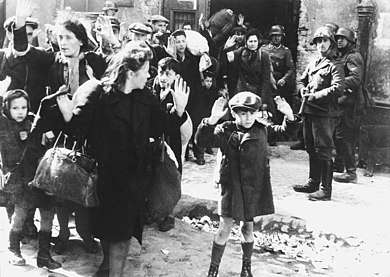
Pre-World War I
Considered to have been the first genocide of the 20th century, the Herero and Namaqua Genocide was perpetrated by the German Empire between 1904 and 1907 in German South West Africa (modern day Namibia), during the scramble for Africa.[1][2][3][4][5] On January 12, 1904, the Herero people, led by Samuel Maharero, rebelled against German colonialism. In August, General Lothar von Trotha of the Imperial German Army defeated the Herero in the Battle of Waterberg and drove them into the desert of Omaheke, where most of them died of thirst. In October, the Nama people also rebelled against the Germans only to suffer a similar fate.
In total, from 24,000 up to 100,000 Herero and 10,000 Nama died.[6][7][8][9][10] The genocide was characterized by widespread death by starvation and thirst because the Herero who fled the violence were prevented from returning from the Namib Desert. Some sources also claim that the German colonial army systematically poisoned desert wells.[11][12]
World War I
.jpg)
Documentation regarding German war crimes in World War I was seized and destroyed by Nazi Germany during World War II, after occupying France, along with monuments commemorating their victims.[13]
Chemical weapons in warfare
Poison gas was first introduced as a weapon by Imperial Germany, and subsequently used by all major belligerents, in violation of the 1899 Hague Declaration Concerning Asphyxiating Gases and the 1907 Hague Convention on Land Warfare, which explicitly forbade the use of "poison or poisoned weapons" in warfare.[14][15]
Belgium
.jpg)
In August 1914, as part of the Schlieffen Plan, the German Army invaded and occupied the neutral nation of Belgium without explicit warning, which violated a treaty of 1839 that the German chancellor dismissed as a "scrap of paper" and the 1907 Hague Convention on Opening of Hostilities.[16] Within the first two months of the war, the German occupiers terrorized the Belgians, killing thousands of civilians and looting and burning scores of towns, including Leuven, which housed the country's preeminent university, mainly in retaliation for Belgian guerrilla warfare, (see francs-tireurs). This action was in violation of the 1907 Hague Convention on Land Warfare provisions that prohibited collective punishment of civilians and looting and destruction of civilian property in occupied territories.[17]
Bombardment of English coastal towns
The raid on Scarborough, Hartlepool and Whitby, which took place on December 16, 1914, was an attack by the Imperial German Navy on the British seaport towns of Scarborough, Hartlepool, West Hartlepool, and Whitby. The attack resulted in 137 fatalities and 592 casualties. The raid was in violation of the ninth section of the 1907 Hague Convention which prohibited naval bombardments of undefended towns without warning,[18] because only Hartlepool was protected by shore batteries.[19] Germany was a signatory of the 1907 Hague Convention.[20] Another attack followed on 26 April 1916 on the coastal towns of Yarmouth and Lowestoft but both were important naval bases and defended by shore batteries.
Unrestricted submarine warfare
Unrestricted submarine warfare was instituted in 1915 in response to the British blockade of Germany and to the British Government's refusal to court-martial the perpetrators of the Baralong incidents. Prize rules, which were codified under the 1907 Hague Convention—such as those that required commerce raiders to warn their targets and allow time for the crew to board lifeboats—were disregarded and commercial vessels were sunk regardless of nationality, cargo, or destination. Following the sinking of the RMS Lusitania on 7 May 1915 and subsequent public outcry in various neutral countries, including the United States, the practice was withdrawn. However, Germany resumed the practice on 1 February 1917 and declared that all merchant ships regardless of nationalities would be sunk without warning. This outraged the U.S. public, prompting the U.S. to break diplomatic relations with Germany two days later, and, along with the Zimmermann Telegram, led the U.S. entry into the war two months later on the side of the Allied Powers.
World War II
Chronologically, the first German World War II crime, and also the very first act of the war, was the bombing of Wieluń, a town where no targets of military value were present.[21][22]
More significantly, The Holocaust of the Jews, the Action T4 killing of the disabled and the Porajmos of the Gypsies are the most notable war crimes committed by Nazi Germany during World War II. Not all of the crimes committed during the Holocaust and similar mass atrocities were war crimes. Telford Taylor (The U.S. prosecutor in the German High Command case at the Nuremberg Trials and Chief Counsel for the twelve trials before the U.S. Nuremberg Military Tribunals) explained in 1982:

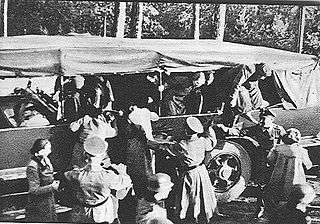
.jpg)

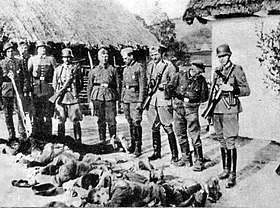

as far as wartime actions against enemy nationals are concerned, the [1948] Genocide Convention added virtually nothing to what was already covered (and had been since the Hague Convention of 1899) by the internationally accepted laws of land warfare, which require an occupying power to respect "family honors and rights, individual lives and private property, as well as religious convictions and liberty" of the enemy nationals. But the laws of war do not cover, in time of either war or peace, a government's actions against its own nationals (such as Nazi Germany's persecution of German Jews). And at the Nuremberg war crimes trials, the tribunals rebuffed several efforts by the prosecution to bring such "domestic" atrocities within the scope of international law as "crimes against humanity."
— Telford Taylor[23]
- German mistreatment of Soviet prisoners of war – at least 3.3 million Soviet POWs died in German custody, out of 5.7 million captured; this figure represents 57% POW casualty rate.
- Le Paradis massacre, May 1940, British soldiers of the Royal Norfolk Regiment, were captured by the SS and subsequently murdered. Fritz Knoechlein was tried, found guilty and hanged.
- Wormhoudt massacre, May 1940, British and French soldiers captured by the SS and subsequently murdered. No one was found guilty of the crime.
- Lidice massacre after assassination of Reinhard Heydrich in 1942, when the Czech village was utterly destroyed, and inhabitants murdered.
- Ardenne Abbey massacre,[24] June 1944 Canadian soldiers captured by the SS and murdered by 12th SS Panzer Division Hitlerjugend. SS General Kurt Meyer (Panzermeyer) sentenced to be shot 1946; sentence commuted; released 1954
- Malmedy massacre, December 1944, United States POWs captured by Kampfgruppe Peiper were murdered outside of Malmedy, Belgium.
- Wereth massacre. 17 December 1944, soldiers from 3./SS-PzAA1 LSSAH captured eleven African-American soldiers from 333rd Artillery Battalion in the hamlet of Wereth, Belgium. Subsequently, the prisoners were shot and had their fingers cut off, legs broken, and at least one was shot while trying to bandage a comrade's wounds.
- Gardelegen (war crime) of April 1945 when Nazi concentration camp prisoners were herded into a barn, which was then set alight, killing all inside
- Oradour-sur-Glane massacre
- Massacre of Kalavryta
- Unrestricted submarine warfare against merchant shipping.
- The intentional destruction of major medieval churches of Novgorod, of monasteries in the Moscow region (e.g., of New Jerusalem Monastery) and of the imperial palaces around St. Petersburg (many of them were left by the post-war authorities in ruins or simply demolished).
- The campaign of extermination of Slavic population in the occupied territories. Several thousand villages were burned with their entire population (e.g., Khatyn massacre in Belarus). A quarter of the inhabitants of Belarus did not survive the German occupation.
- Commando Order, the secret order issued by Hitler in October 1942 stating that Allied combatants encountered during commando operations were to be executed immediately without trial, even if they were properly uniformed, unarmed, or intending to surrender.
- Commissar Order, the order from Hitler to Wehrmacht troops before the invasion of the Soviet Union in 1941 to shoot Commissars immediately on capture
- Nacht und Nebel decree of 1941 for disappearance of prisoners
War criminals
- List of Axis personnel indicted for war crimes
- List of Nazi doctors
- Adolf Eichmann
- Heinrich Gross
- Hans Heinze
- Rudolf Hoess
- Karl Linnas
- Josef Mengele
- Otmar Freiherr von Verschuer
- Alfred Trzebinski
Massacres and war crimes of World War II by location
Austria
- Murders of disabled children by Heinrich Gross
- Recommendation of disabled children for euthanasia by Hans Asperger
Belarus
- The Holocaust in Belarus
- Anti-partisan operations in Belarus
- Operation Bamberg
- Operation Cottbus
- 1941
- 28 September – 17 October, Pleszczenice-Bischolin-Szack (Šacak)-Bobr-Uzda (White Ruthenia) massacre (1,126 children)
- 1942
- 26 March – 6 April, Operation Bamberg (Hłusk, Bobrujsk; 4,396 people, including children)
- 9 – 12 May, Kliczów-Bobrujsk massacre (520 people, including children)
- Beginning of June, Słowodka-Bobrujsk massacre (1,000 people, including children)
- 15 June Borki (powiat białostocki) massacre (1,741 people, including children)
- 21 June Zbyszin massacre (1,076 people, including children)
- 25 June Timkowiczi massacre (900 people, including children)
- 26 June Studenka massacre (836 people, including children)
- 18 July, Jelsk massacre (1,000 people, including children)
- 15 July – 7 August, Operation Adler (Bobrujsk, Mohylew, Berezyna; 1,381 people, including children)
- 14 – 20 August, Operation Greif (Orsza, Witebsk; 796 people, including children)
- 22 August – 21 September, Operation Sumpffieber (White Ruthenia; 10,063 people, including children)
- August, Bereźne massacre
- 22 September – 26 September, Małoryta massacre; 4,038 people, including children)
- 23 September – 3 October, Operation Blitz (Połock, Witebsk; 567 people, including children)
- 11 – 23 October, Operation Karlsbad (Orsza, Witebsk; 1,051 people, including children)
- 23 – 29 November, Operation Nürnberg (Dubrowka; 2,974 people, including children)
- 10 – 21 December, Operation Hamburg (Niemen River-Szczara River; 6,172 people, including children)
- 22 – 29 December, Operation Altona (Słonim; 1,032 people, including children)
- 1943
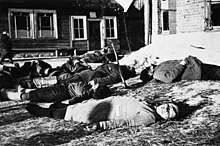 Mass murder of Soviet civilians near Minsk, 1943
Mass murder of Soviet civilians near Minsk, 1943
- 6 – 14 January, Operation Franz (Grodsjanka; 2,025 people, including children)
- 10 – 11 January, Operation Peter (Kliczów, Kolbcza; 1,400 people, including children)
- 18 – 23 January, Słuck-Mińsk-Czerwień massacre (825 people, including children)
- 28 January – 15 February, Operation Schneehase; Połock, Rossony, Krasnopole; 2,283 people, including children); 54; 37
- Until 28 January, Operation Erntefest I (Czerwień, Osipowicze; 1,228 people, including children)
- Jaanuar, Operation Eisbär (between Briańsk and Dmitriev-Lgowski)
- Until 1 February, Operation Waldwinter (Sirotino-Trudy; 1,627 people, including children)
- 8 – 26 February, Operation Hornung (Lenin, Hancewicze; 12,897 people, including children)
- Until 9 February, Operation Erntefest II (Słuck, Kopyl; 2,325 people, including children)
- 15 February – end of March, Operation Winterzauber (Oświeja, Latvian border; 3,904 people, including children)
- 22 February – 8 March, Operation Kugelblitz (Połock, Oświeja, Dryssa, Rossony; 3,780 people, including children)
- Until 19 March, Operation Nixe (Ptycz, Mikaszewicze, Pińsk; 400 people, including children)
- Until 21 March, Operation Föhn (Pińsk; 543 people, including children)
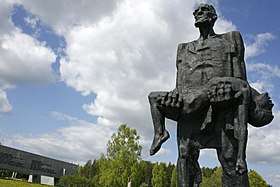 Khatyn Memorial. The sculpture depicts Yuzif Kaminsky, the only adult to survive the massacre, holding his dead son Adam.
Khatyn Memorial. The sculpture depicts Yuzif Kaminsky, the only adult to survive the massacre, holding his dead son Adam. - 21 March – 2 April, Operation Donnerkeil (Połock, Witebsk; 542 people, including children)
- 1 – 9 May, Operation Draufgänger II (Rudnja and Manyly forest; 680 people, including children)
- 17 – 21 May, Operation Maigewitter (Witebsk, Suraż, Gorodok; 2,441 people, including children)
- 20 May – 23 June, Operation Cottbus (Lepel, Begomel, Uszacz; 11,796 people, including children)
- 27 May – 10 June, Operation Weichsel (Dniepr-Prypeć triangle, South-West of Homel; 4,018 people, including children)
- 13 – 16 June, Operation Ziethen (Rzeczyca; 160 people, including children)
- 25 June – 27 July, Operation Seydlitz (Owrucz-Mozyrz; 5,106 people, including children)
- 30 July, Mozyrz massacre (501 people, including children)
- Until 14 July, Operation Günther (Woloszyn, Lagoisk; 3,993 people, including children)
- 13 July – 11 August, Operation Hermann (Iwie, Nowogródek, Woloszyn, Stołpce; 4,280 people, including children)
- 24 September – 10 October, Operation Fritz (Głębokie; 509 people, including children)
- 9 October – 22 October, Stary Bychów massacre (1,769 people, including children)
- 1 November – 18 November, Operation Heinrich (Rossony, Połock, Idrica; 5,452 people, including children)
- December, Spasskoje massacre (628 people, including children)
- December, Biały massacre (1,453 people, including children)
- 20 December – 1 January 1944, Operation Otto (Oświeja; 1,920 people, including children)
- 1944
- 14 January, Oła massacre (1,758 people, including children)
- 22 January, Baiki massacre (987 people, including children)
- 3 – 15 February, Operation Wolfsjagd (Hłusk, Bobrujsk; 467 people, including children)
- 5 – 6 February, Barysz (near Buczacz) massacre (126 people, including children; see pl:Zbrodnie w Baryszu)
- Until 19 February, Operation Sumpfhahn (Hłusk, Bobrujsk; 538 people, including children)
- Beginning of March, Berezyna-Bielnicz massacre (686 people, including children)
- 7 – 17 April, Operation Auerhahn (Bobrujsk; c. 1,000 people, including children)
- 17 April – 12 May, Operation Frühlingsfest (Połock, Uszacz; 7,011 people, including children)
- 25 May – 17 June, Operation Kormoran; (Wilejka, Borysów, Minsk; 7,697 people, including children)
- 2 June – 13 June, Operation Pfingsrose (Talka; 499 people, including children)
- June, Operation Pfingstausnlug (Sienno; 653 people, including children)
- June, Operation Windwirbel (Chidra; 560 people, including children)
Belgium
- 1940
- May 25, Vinkt Massacre (Vinkt, East Flanders; 86-140 people, including children)
- 1944
- August 18, Courcelles Massacre (Courcelles, Province of Hainaut; 20 People, including children)
- December, Malmedy massacres (Malmedy and surrounding region; at least 373 American POWS)
- Dec 17, Baugnez crossroads massacre (Baugnez (near Malmedy), Province of Liège; 81 American POWS)
- Dec 17, Wereth massacre (Wereth, Province of Liège; 11 American POWS)
- Dec 24, Bande Massacre (Bande, Province of Luxembourg; 34 People aged between 20-31 years old)
Czechoslovakia
- Lidice massacre
- Ležáky massacre
- Kobylisy Shooting Range, a site of execution for primarily political prisoners
- Životice massacre
- War crimes during the Prague uprising included using civilians as human shields, summary executions and massacres
- Massacre in Trhová Kamenice
Estonia
- The Holocaust in Estonia
- Murders of children by Karl Linnas
- 1941
- 2 November, Mass murder of children in Pärnu synagogue (34 children)
- 1942
- 27 March Murder of Pliner children (Holocaust in Estonia; 3 children)
France
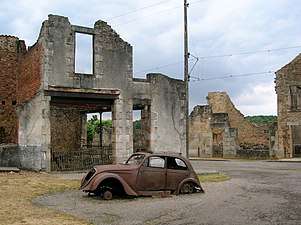
- Affair of 27 martyrs 25 August 1945
- Ascq massacre April 1944
- Ardenne Abbey massacre of British and Canadian troops by Waffen-SS
- Drancy internment camp murders
- Dortan Massacre
- Dun-les-Places massacre
- First Saint-Julien massacre
- Graignes massacre
- Izieu orphanage deportations to Auschwitz, 6 April 1944
- Karl Hotz reprisals
- Le Paradis massacre
- Massacre of the Bois d'Eraine
- Maillé massacre
- Penguerec massacre
- Massacre de la vallée de la Saulx
- Saint-Genis-Laval massacre
- Second Saint-Julien massacre
- Tragedy of the Guerry's wells
- Tulle massacre, 9 June 1944
- Oradour-sur-Glane massacre (642 men, women and children) 10 June 1944
- Wormhoudt massacre
Germany

- Action T4
- Murders of children in the Hadamar Clinic (NS-Tötungsanstalt Hadamar) mostly by Irmgard Huber
- Murders of children by Hans Heinze
- Otmar Freiherr von Verschuer#Involvement in Nazi human experimentation
- 1945
- 8 April - The Celle Massacre
- 13 April - Gardelegen Massacre
- 20 April - Murder of 20 children by Alfred Trzebinski
Greece

- Massacre of Kleisoura (Macedonia, 270 women and children)
- Massacre of Kondomari (Crete, 60 men, mainly elder)
- Massacre of Pikermi (Pikermi, 54, including women children)
- Pyrgoi (former Katranitsa) massacre (Pyrgoi, 346, including women children)
- Razing of Kandanos (Crete, 180, including women children)
- Holocaust of Viannos (Crete, 500+, including women children)
- Distomo massacre (Central Greece, 218, including women children)
- Drakeia massacre (Thessaly, 118 men)
- Holocaust of Kedros (Crete, 164, including women children)
- Massacre of Kommeno (Epirus, 317, including women children)
- Massacre of Kalavryta (Peloponnese, 1,200+, including women children)
- Burnings of Kali Sykia (Crete, 13, women)
- Lyngiades massacre (Epirus), 92, mostly infants, children, women and elderly
- Massacre of the Acqui Division (Kefalonia, 5,000, Italian anti-fascist troops)
- Mesovouno massacre (Macedonia, 268, including women and children)
- Paramythia executions (Epirus, 201, including women children)
- The Massacre of Chortiatis (Macedonia, 146, including women children)
- Executions of Kaisariani (Athens, 200+, all civilians)
- Massacre of Mousiotitsa (Epirus, 153, including women children)
- Malathyros executions (Malathyros, 61, including women children)
- Executions of Kokkinia (Athens, 300+, all civilians, assisted by Security Battalions)
- Kallikratis executions (Kallikratis, 30, including women children)
- Alikianos executions (Crete, 118, all civilians)
- Razing of Anogeia (Crete, unknown, including women and children)
In addition, more than 90 villages and towns are recorded from the Hellenic network of martyr cities.[25] During the triple German, Italian and Bulgarian, occupation about 800,000 people lost their lives in Greece (see World War II casualties).
Italy

- 29 September – 5 October 1944, Marzabotto massacre (Marzabotto, Emilia-Romagna; between 770 and 1,830 civilians killed)
- 12 August 1944, Sant'Anna di Stazzema massacre (Sant'Anna di Stazzema, Tuscany; 560 people, including children)
- 29 June 1944, Civitella-Cornia-San Pancrazio massacre (Abruzzo; 203 people, including children)
- Ardeatine massacre (Rome, Lazio; 335 prisoners executed)
- Boves massacre (Cuneo, Piedmont; 189 civilians and partisans killed in two separate massacres)[26]
- Padule di Fucecchio massacre (Fucecchio, Tuscany; 176 civilians killed on 23 August 1944)[27]
- Cavriglia-Castelnuovo dei Sabbioni massacre (Tuscany; 173 civilians killed on 4 July 1944)[27]
- Vinca massacre (Fivizzano, Tuscany; between 160[28] and 178[29] civilians executed on 24 August 1944)
- Fosse del Frigido massacre (Massa, Tuscany; 146-149 prisoners murdered on 10 September 1944)[29]
- Pietransieri massacre (Roccaraso, Abruzzo; 128 civilians killed on 21 November 1943)[30]
- Stia massacre (Stia, Tuscany; 122 civilians killed between 12 and 15 April 1944)[28]
- San Terenzo Monti massacre (Fivizzano, Tuscany; 110 civilians and 52 political prisoners killed on 21 August 1944)[28]
- Valla massacre (Fivizzano, Tuscany; 103 civilians killed on 19 August 1944)[29]
- Serra di Ronchidoso massacre (Gaggio Montano, Emilia-Romagna; over 100 civilians killed on 28–29 September 1944)[27]
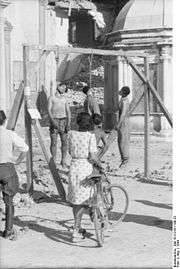 Three men executed by public hanging in a street of Rimini, 1944
Three men executed by public hanging in a street of Rimini, 1944 - Verghereto massacre (Verghereto, Emilia-Romagna; 96 civilians killed between 22 and 25 July 1944)[27]
- Massacre of Monchio, Susano and Costrignano (Palagano, Emilia-Romagna; between 79[28] and 136 civilians killed on 18 March 1944)
- Leonessa and Cumulata massacre (Leonessa, Lazio; 51 civilians killed between 2 and 7 April 1944)
- Cumiana massacre (Cumiana, Piedmont; 51 civilians killed on 3 April 1944)
- Tavolicci massacre (Verghereto, Emilia-Romagna; 64 civilians killed on 22 July 1944)
- Forno massacre (Massa, Tuscany; 72 civilians killed on 13 June 1944)
- Gubbio massacre (Gubbio, Umbria; 40 civilians executed on 22 June 1944)[28]
- Valdine massacre (Fivizzano, Tuscany; 52 hostages executed in August 1944)[28]
- Casaglia massacre (Marzabotto, Emilia-Romagna; 42 civilians killed on 29 September 1944)[28]
- Bergiola Foscalina massacre in Carrara (Carrara, Tuscany; 72 civilians killed on 16 September 1944)[27]
- Madonna dell'Albero massacre (Ravenna, Emilia-Romagna; 56 civilians killed on 27 November 1944)
- "La Romagna" massacre (Molina di Quosa, San Giuliano Terme, Tuscany; 75 civilians killed on 11 August 1944)[27]
- San Polo di Arezzo massacre (Arezzo, Tuscany; 65 civilians killed on 14 July 1944)[27]
- Certosa di Farneta massacre (Lucca, Tuscany; 60 civilians killed between 2 and 10 September 1944)[27]
- Guardistallo massacre (Guardistallo, Tuscany; 46 civilians killed on 29 June 1944)[27]
- Massaciuccoli-Massarosa massacre (Massaciuccoli, Massarosa, Tuscany; 41 civilians killed between 2 and 5 September 1944)[27]
- Fossoli-Carpi massacre (Carpi, Emilia-Romagna; 67 civilians killed on 12 July 1944)[27]
- Turchino Pass massacre (Fontanafredda, Liguria; 59 civilians executed on 19 May 1944)[29]
- Pedescala massacre (Valdastico, Veneto; 82 civilians killed between 30 April and 2 May 1945)[29]
Latvia

- 1941
- 30 November and 8 December, Rumbula massacre (25,000 people, including children)[31]
Lithuania

- 1941
- 13 July – 21 August Daugavpils massacre by Einsatzkommando 3 (9,585 people, including children)[32]
- July–August 1944, Ponary massacre (c. 100,000 people, including children)
- 18 August – 22 August, Kreis Rasainiai massacre (1,020 children)
- 19 August, Ukmerge massacre (88 children)
- Summer-autumn-winter, Complete murder of native Jewish population in Estonia (900 individuals, including 101 children)
- 1 September, Marijampolė massacre (1,404 children)
- 2 September, Wilno massacre (817 children)
- 4 September, Čekiškė massacre (60 children)
- 4 September, Seredžius massacre (126 children)
- 4 September, Veliuona massacre (86 children)
- 4 September, Zapyškis massacre (13 children)
- 6 September – 8 September, Raseiniai massacre (415 children)
- 6 September – 8 September, Jurbork massacre (412 people, including children)
- 29 October, Kaunas massacre (4,273 children)
- 25 November, Kauen-F.IX massacre (175 children)
Netherlands
- 1940
- 14 May, Rotterdam bombing (nearly 1,000 people were killed and 85,000 made homeless.)
- 1944
- 1 October, Putten raid (552 deaths)
- 5 November, Heusden Town Hall Massacre (134 people, including 74 children)
Norway
- Attempted deportation of children of Jewish Children's Home in Oslo
Poland
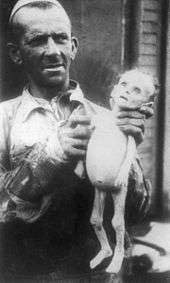
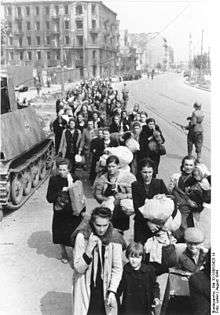
- The Holocaust in Poland
- Bombing of Wieluń
- Borów massacre (103 children)
- Expulsion of Poles by Nazi Germany
- German AB-Aktion in Poland
- Gmina Aleksandrów, Lublin Voivodeship
- Gmina Besko
- Gmina Gidle
- Gmina Kłecko
- Gmina Ryczywół
- Gmina Siennica
- Huta Pieniacka massacre
- Intelligenzaktion Pommern
- Jedwabne pogrom
- Jeziorko woodland cemetery
- Kidnapping of Polish children by Nazi Germany
- Krasowo-Częstki massacre (83 children)
- Lviv pogroms
- Massacres of Poles in Volhynia
- Michniów massacre (48 children)
- Murders of children by Josef Mengele
- Pacification Operations in German occupied Poland
- Planned destruction of Warsaw
- Ponary massacre
- Operation Tannenberg
- Szczecyn massacre (71 children)
- Valley of Death (Bydgoszcz)

- 1942
- 2 July, murder of children of Lidice in the Kulmhof extermination camp (82 children)
- 1943
- 12 March, Murder of Czesława Kwoka in KZ Auschwitz-Birkenau (1 child)
- 23 May, Kielce cemetery massacre (45 children)
- 3 August, Szczurowa massacre (93 people, including children)
- 29 September, Ostrówki massacre (246 children)
- 29 September, Wola Ostrowiecka massacre (220 children)
- 1944
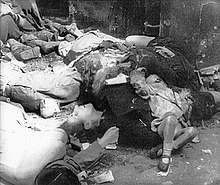
- 28 February, Huta Pieniacka massacre
- 28 – 29 February, Korosciatyn Massacre (c. 150 people, including children)
- 2 June, Murder of Yekusiel Yehudah Halberstam's children (9 children)
- 4–August 25, Ochota massacre (c. 10,000 people, including children)
- 5 – 8 August, Wola massacre (40,000[33] up to 100,000[34] people, including children)
Russia
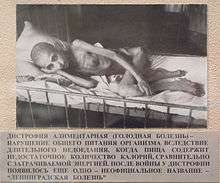
- The Holocaust in Russia
- Commissar Order
- World War II German war crimes in the Soviet Union
- German war crimes during the Battle of Moscow
Serbia
- 1941
- 20–21 October Kragujevac massacre (2300–5000 civilians killed, including 217 children)
- 15-20 October Kraljevo massacre (2000 civilians killed)
Slovenia
- 1942
- 22 july Celje prison massacre (Celje, 100 civilians killed)
- 2 October Maribor prison massacre (Maribor, 143 civilians killed)
- 1945
- 12 February Frankolovo crime (Frankolovo, 100 civilians killed)
Ukraine
- The Holocaust in Ukraine
- Babi Yar
- List of victims of the Babi Yar massacre
- Drobytsky Yar
- Lviv pogroms
- Massacres of Poles in Volhynia
- 1941
- June, Czechow massacre (6 children)
- 29 – 30 September, Babi Jar massacre (33,771 people, including children: List of victims of the Babi Yar massacre)
- 1943
- 1 – 2 March 1943, Koriukivka massacre
- 19 March 1943, Ozerjany massacre (267 people).[35]
- Second half of March, Kharkov massacre following the Third Battle of Kharkov (2500 people).[36]
- 29 September, Wola Ostrowiecka massacre (220 children)
- 1944
- 28 February, Huta Pieniacka massacre
- 28 – 29 February, Korosciatyn Massacre (c. 150 people, including children)
- 11 April
See also
| Wikimedia Commons has media related to War crimes committed by Germany. |
| Wikimedia Commons has media related to Child Holocaust victims. |
- Racial policy of Nazi Germany
- War crimes of the Wehrmacht
- Nazi crime
- Nazism
- Bombing of Guernica
- Chronicles of Terror
- Command responsibility
- Consequences of Nazism
- Einsatzgruppen
- Generalplan Ost
- Nazi concentration camps
- Italian war crimes
- British war crimes
- Internment of German Americans
- List of Axis personnel indicted for war crimes
- List of war crimes
- Nazi crimes against the Polish nation
- Pacification actions in German-occupied Poland
- Soviet war crimes
- Nuremberg trials
- War crimes in occupied Poland during World War II
- Allied war crimes during World War II
Notes
- Olusoga, David and Erichsen, Casper W (2010). The Kaiser's Holocaust. Germany's Forgotten Genocide and the Colonial Roots of Nazism. Faber and Faber. ISBN 978-0-571-23141-6
- Levi, Neil; Rothberg, Michael (2003). The Holocaust: Theoretical Readings. Rutgers University Press. p. 465. ISBN 0-8135-3353-8.
- Mahmood Mamdani, When Victims Become Killers: Colonialism, Nativism, and the Genocide in Rwanda, Princeton University Press, Princeton, 2001, p. 12
- Allan D. Cooper (2006-08-31). "Reparations for the Herero Genocide: Defining the limits of international litigation". Oxford Journals African Affairs.
- "Remembering the Herero Rebellion". Deutsche Welle. 2004-11-01.
- Colonial Genocide and Reparations Claims in the 21st Century: The Socio-Legal Context of Claims under International Law by the Herero against Germany for Genocide in Namibia, 1904–1908 (PSI Reports) by Jeremy Sarkin-Hughes
- Empire, Colony, Genocide: Conquest, Occupation and Subaltern Resistance in World History (War and Genocide) (War and Genocide) (War and Genocide) A. Dirk Moses -page 296(From Conquest to Genocide: Colonial Rule in German Southwest Africa and German East Africa. 296, (29). Dominik J. Schaller)
- The Imperialist Imagination: German Colonialism and Its Legacy (Social History, Popular Culture, and Politics in Germany) by Sara L. Friedrichsmeyer, Sara Lennox, and Susanne M. Zantop page 87 University of Michigan Press 1999
- Walter Nuhn: Sturm über Südwest. Der Hereroaufstand von 1904. Bernard & Graefe-Verlag, Koblenz 1989. ISBN 3-7637-5852-6.
- Marie-Aude Baronian, Stephan Besser, Yolande Jansen, "Diaspora and memory: figures of displacement in contemporary literature, arts and politics", pg. 33 Rodopi, 2007,
- Samuel Totten, William S. Parsons, Israel W. Charny, "Century of genocide: critical essays and eyewitness accounts" pg. 51, Routledge, 2004,
- Dan Kroll, "Securing our water supply: protecting a vulnerable resource", PennWell Corp/University of Michigan Press, pg. 22
- France: the dark years, 1940–1944 page 273 Julian Jackson Oxford University Press 2003
- Telford Taylor (November 1, 1993). The Anatomy of the Nuremberg Trials: A Personal Memoir. Little, Brown and Company. ISBN 0-3168-3400-9. Retrieved 20 June 2013.
- Thomas Graham, Damien J. Lavera (May 2003). Cornerstones of Security: Arms Control Treaties in the Nuclear Era. University of Washington Press. pp. 7–9. ISBN 0-2959-8296-9. Retrieved 5 July 2013.
- Robinson, James J., ABA Journal 46(9), p. 978.
- Spencer C. Tucker, Priscilla Mary Roberts (October 25, 2005). World War I: A Student Encyclopedia. Santa Barbara, California: ABC-CLIO. pp. 1074. ISBN 1-8510-9879-8.CS1 maint: uses authors parameter (link)
- Logan Marshall (1915). Horrors and atrocities of the great war: Including the tragic destruction of the Lusitania: A new kind of warfare: Comprising the desolation of Belgium: The sacking of Louvain: The shelling of defenseless cities: The wanton destruction of cathedrals and works of art: The horrors of bomb dropping: Vividly portraying the grim awfulness of this greatest of all wars fought on land and sea: In the air and under the waves: Leaving in its wake a dreadful trail of famine and pestilence. G. F. Lasher. p. 240. Retrieved 5 July 2013.
German Navy December 1914 Hague Convention bombardment.
- Chuter, David (2003). War Crimes: Confronting Atrocity in the Modern World. London: Lynne Rienner Pub. p. 300. ISBN 1-58826-209-X.
- Willmore, John (1918). The great crime and its moral. New York: Doran. p. 340.
- Kulesza, Witold (2004). ""Wieluń polska Guernica", Tadeusz Olejnik, Wieluń 2004 : [recenzja]" ["Wieluń Polish Guernica", Tadeusz Olejnik, Wieluń 2004 : [review]] (PDF). Rocznik Wieluński (in Polish). 4: 253–254.
- David Gilbertson (14 August 2017). The Nightmare Dance: Guilt, Shame, Heroism and the Holocaust. Troubador Publishing Limited. p. 27. ISBN 978-1-78306-609-4.
- Telford Taylor "When people kill a people" in The New York Times, March 28, 1982
- "Home - Veterans Affairs Canada". Vac-acc.gc.ca. 2012-03-29. Archived from the original on 2006-11-21. Retrieved 9 July 2012.
- Δήμος Λαμιέων: Δίκτυο μαρτυρικών πόλεων & χωριών της Ελλάδος | Δήμος Λαμιέων, accessdate: 19. Oktober 2015
- "www.anpi.it/storia/212/strage-di-boves". anpi.it. Archived from the original on 2 February 2016. Retrieved 14 February 2017.
- Buzzelli, S.; De Paolis, M.; Speranzoni, A. (2012). La ricostruzione giudiziale dei crimini nazifascisti in Italia: questioni preliminari. G. Giappichelli. p. 119. ISBN 9788834826195. Retrieved 14 February 2017.
- "Crimini di guerra". criminidiguerra.it. Retrieved 14 February 2017.
- Biacchessi, D. (2015). I carnefici. SPERLING & KUPFER. ISBN 9788820092719. Retrieved 14 February 2017.
- "L`eccidio di Pietransieri - Rai Storia". raistoria.rai.it. Retrieved 14 February 2017.
- "Complete tabulation of executions carried out in the Einsatzkommando 3 zone up to 1 December 1941". Holocaust-history.org. Retrieved 4 May 2012.
- "Gesamtaufstellung der im Bereich des EK. 3 bis zum 1. Dez. 1941 durchgeführten Exekutionen". Holocaust-history.org. 2002-09-28. Retrieved 4 May 2012.
- Muzeum Powstania otwarte, BBC Polish edition, 2 October 2004, Children accessed on 13 April 2007
- O Powstaniu Warszawskim opowiada prof. Jerzy Kłoczowski, Gazeta Wyborcza – local Warsaw edition, 1998-08-01. Children accessed on 13 April 2007
- "24 Октября 1943 г." www.army.lv (in Russian). Retrieved 2018-04-20.
- "19 Октября 1943 г." www.army.lv (in Russian). Retrieved 2018-04-20.
References
- This article incorporates text from the United States Holocaust Memorial Museum, and has been released under the GFDL.
- United States Holocaust Memorial Museum – Article Children during the Holocaust; and online exhibitions Life in the Shadows; and Give Me Your Children
- Holocaust Memorial Album Honoring more than 1.5 Million Souls Under 12 years of age that never returned ... from Holocaust Survivors and Remembrance Project: "Forget You Not"
- Children and the Holocaust
- Nazis kidnap Polish children
- The War Crimes of Dr Josef Mengele
- German War Crimes of World War I
- The Reich's forgotten atrocity
- Media (on-line)
- Poland under German occupation 1939–1945 on YouTube
- The Atrocities committed by German-Fascists in the USSR
- Stills from Soviet documentary "The Atrocities committed by German Fascists in the USSR" ((1); (2); (3))
- Slide show "Nazi Crimes in the USSR (Graphic images!)"